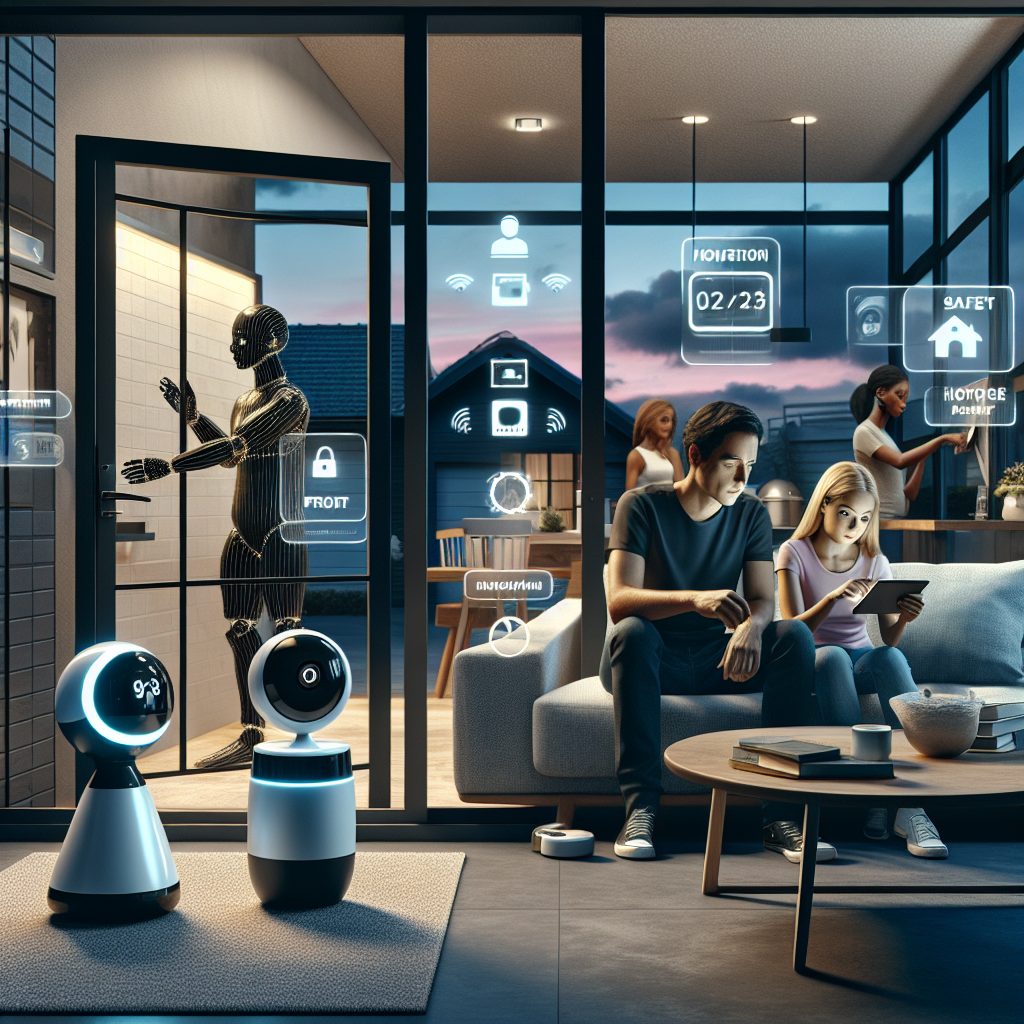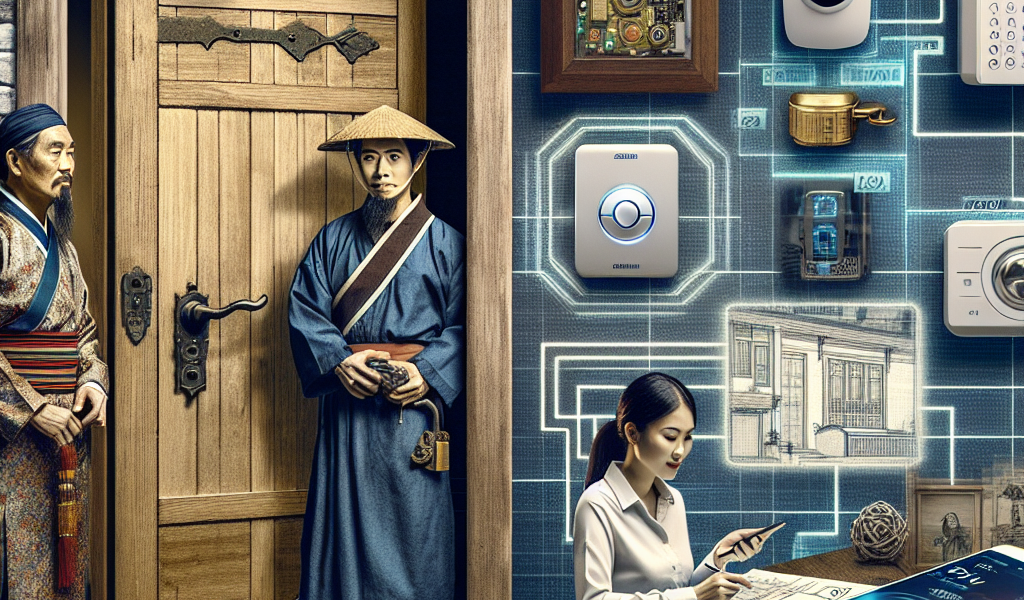-
Table of Contents
“Empowering Peace of Mind: The Future of Home Security Through Technology”
Introduction

In recent years, technology has dramatically transformed various aspects of our daily lives, and home security is no exception. The advent of smart home devices, advanced surveillance systems, and integrated security solutions has revolutionized the way we protect our homes and loved ones. From smart locks and video doorbells to AI-powered cameras and comprehensive security ecosystems, modern technology offers unprecedented levels of convenience, control, and peace of mind. This revolution in home security not only enhances the effectiveness of traditional measures but also introduces innovative features that were once the stuff of science fiction. As we delve into the myriad ways technology is reshaping home security, it becomes clear that the future of safeguarding our homes is not just about stronger locks and alarms, but about creating intelligent, responsive, and interconnected environments that proactively deter threats and ensure safety.
Smart Home Security Systems: The Future Of Home Protection
In recent years, the landscape of home security has undergone a dramatic transformation, thanks to the rapid advancements in technology. Gone are the days when a simple lock and key were sufficient to protect one’s home. Today, smart home security systems are at the forefront of this revolution, offering homeowners unprecedented levels of protection, convenience, and peace of mind. These systems are not only more effective but also more accessible and user-friendly, making them an attractive option for a wide range of consumers.
One of the most significant changes brought about by smart home security systems is the integration of various devices and sensors that work together seamlessly. For instance, modern systems often include smart cameras, motion detectors, door and window sensors, and even smart locks. These components are interconnected through a central hub, which can be controlled via a smartphone app. This level of integration allows homeowners to monitor and manage their security systems from anywhere in the world, providing real-time updates and alerts.
Moreover, the advent of artificial intelligence (AI) and machine learning has further enhanced the capabilities of smart home security systems. AI-powered cameras can now distinguish between different types of movement, such as a person walking versus a tree branch swaying in the wind. This reduces the number of false alarms and ensures that homeowners are only notified of genuine threats. Additionally, some systems can even recognize familiar faces, allowing them to differentiate between family members and potential intruders.
Another notable advancement is the incorporation of voice control through virtual assistants like Amazon Alexa, Google Assistant, and Apple’s Siri. This feature enables users to control their security systems using simple voice commands, adding an extra layer of convenience. For example, a homeowner can ask their virtual assistant to arm the security system, lock the doors, or even check the status of various sensors. This hands-free approach is particularly beneficial for individuals with mobility issues or those who simply prefer the ease of voice commands.
Furthermore, smart home security systems are becoming increasingly customizable, allowing homeowners to tailor their setups to meet their specific needs. Whether it’s adding extra cameras to cover blind spots, integrating smart lighting to deter potential intruders, or setting up automated routines that simulate occupancy when the house is empty, the possibilities are virtually endless. This level of customization ensures that each home is protected in a way that best suits its unique layout and the homeowner’s lifestyle.
In addition to these technological advancements, the cost of smart home security systems has also become more affordable. While early adopters may have faced steep prices, increased competition and advancements in manufacturing have driven costs down. This has made high-quality security solutions accessible to a broader audience, democratizing home protection and ensuring that more people can benefit from these innovations.
Despite these numerous advantages, it’s important to acknowledge that smart home security systems are not without their challenges. Concerns about privacy and data security are paramount, as these systems often collect and store sensitive information. Manufacturers must prioritize robust encryption and secure data handling practices to mitigate these risks. Additionally, as with any technology, there is always the potential for technical glitches or malfunctions. Regular maintenance and updates are essential to ensure that these systems continue to operate effectively.
In conclusion, smart home security systems represent the future of home protection, offering a blend of advanced technology, convenience, and customization. As these systems continue to evolve, they will undoubtedly become an integral part of modern living, providing homeowners with the peace of mind they deserve. With ongoing advancements and a focus on addressing potential challenges, the future of home security looks brighter than ever.
The Role Of Artificial Intelligence In Enhancing Home Security
Artificial intelligence (AI) is rapidly transforming various aspects of our lives, and home security is no exception. As technology continues to advance, AI is playing an increasingly pivotal role in enhancing the safety and security of our homes. This revolution is not just about adding more gadgets but about creating smarter, more responsive systems that can adapt to our needs and provide a higher level of protection.
One of the most significant ways AI is revolutionizing home security is through the development of intelligent surveillance systems. Traditional security cameras have long been a staple in home security, but they often require constant monitoring and can produce a high number of false alarms. AI-powered cameras, on the other hand, can analyze video footage in real-time, distinguishing between different types of movement and identifying potential threats more accurately. For instance, these smart cameras can differentiate between a person, an animal, or a swaying tree branch, thereby reducing the number of false alerts and ensuring that homeowners are only notified of genuine security concerns.
Moreover, AI is enhancing home security through advanced facial recognition technology. This technology allows security systems to identify and verify individuals who approach the home, providing an additional layer of security. By recognizing familiar faces, the system can grant access to trusted individuals while alerting homeowners to the presence of unknown visitors. This capability is particularly useful for families with children, as it ensures that only authorized persons can enter the home.
In addition to surveillance and facial recognition, AI is also improving home security through the integration of smart home devices. These devices, such as smart locks, doorbells, and lighting systems, can be controlled remotely via smartphone apps, allowing homeowners to monitor and manage their security from anywhere in the world. AI algorithms can analyze patterns in the usage of these devices, learning the habits and routines of the household. This enables the system to detect unusual activity and respond accordingly, such as locking doors or turning on lights when unexpected movement is detected.
Furthermore, AI-powered home security systems are becoming more proactive in preventing potential threats. For example, some systems can analyze data from various sensors and predict when a break-in might occur based on patterns of suspicious behavior. By identifying these patterns early, the system can alert homeowners and authorities before a crime takes place, potentially preventing it altogether. This predictive capability represents a significant advancement over traditional reactive security measures.
Another notable benefit of AI in home security is its ability to integrate with other technologies to create a comprehensive security ecosystem. For instance, AI can work in conjunction with the Internet of Things (IoT) to connect various devices and systems within the home. This interconnectedness allows for seamless communication between devices, enhancing the overall effectiveness of the security system. For example, if a smart camera detects an intruder, it can trigger the smart lighting system to turn on all the lights in the house, potentially deterring the intruder and alerting neighbors to the situation.
As AI continues to evolve, its role in home security will undoubtedly expand, offering even more sophisticated and effective solutions. The integration of AI into home security systems is not just about keeping intruders out; it’s about creating a safer, more responsive environment that adapts to the unique needs of each household. With AI at the helm, the future of home security looks brighter and more secure than ever before.
How IoT Devices Are Transforming Home Surveillance
In recent years, the advent of the Internet of Things (IoT) has significantly transformed various aspects of our daily lives, and home security is no exception. IoT devices, which connect to the internet and communicate with each other, are revolutionizing home surveillance by offering unprecedented levels of convenience, efficiency, and peace of mind. As these smart devices become more integrated into our homes, they are reshaping the way we think about and approach home security.
One of the most notable changes brought about by IoT devices is the ability to monitor our homes remotely. Gone are the days when homeowners had to rely solely on traditional alarm systems and hope for the best. Today, with the help of smart cameras, doorbells, and sensors, individuals can keep an eye on their property from virtually anywhere in the world. For instance, smart doorbells equipped with high-definition cameras and motion sensors allow homeowners to see and speak with visitors in real-time through their smartphones. This not only enhances security but also adds a layer of convenience, as users can interact with delivery personnel or guests without being physically present.
Moreover, IoT devices are making home surveillance more intelligent and responsive. Advanced features such as facial recognition, artificial intelligence, and machine learning enable these devices to distinguish between familiar faces and potential intruders. This means that homeowners receive fewer false alarms and more accurate notifications. For example, a smart camera can alert the homeowner if it detects an unfamiliar face near the front door, while ignoring the movements of family members or pets. This level of precision helps to ensure that security alerts are both timely and relevant.
In addition to enhancing monitoring capabilities, IoT devices are also improving the overall integration of home security systems. Many smart home security products are designed to work seamlessly with other IoT devices, creating a cohesive and interconnected ecosystem. For example, a smart lock can be programmed to automatically lock the doors when the security system is armed, or a smart light can be set to turn on when motion is detected outside the house. This level of automation not only simplifies the management of home security but also adds an extra layer of protection by creating the illusion of an occupied home, even when the residents are away.
Furthermore, the rise of IoT devices has made home security more accessible and affordable for a wider range of consumers. Traditional security systems often required professional installation and came with hefty monthly fees. In contrast, many IoT-based security products are designed for easy DIY installation and offer flexible pricing models. This democratization of home security means that more people can take advantage of advanced surveillance technologies without breaking the bank.
However, it is important to acknowledge that the increasing reliance on IoT devices for home security also raises concerns about privacy and data security. As these devices collect and transmit sensitive information, they can become targets for cyberattacks. To mitigate these risks, manufacturers and users alike must prioritize robust security measures, such as encryption, regular software updates, and strong passwords.
In conclusion, IoT devices are undeniably transforming home surveillance by providing enhanced monitoring capabilities, intelligent features, seamless integration, and greater accessibility. As technology continues to evolve, it is likely that we will see even more innovative solutions that further enhance the safety and security of our homes. While challenges such as privacy and data security must be addressed, the benefits of IoT-enabled home security systems are clear, offering homeowners a powerful tool to protect their property and loved ones.
Conclusion
Technology is revolutionizing home security by integrating advanced systems such as smart cameras, motion sensors, and automated locks, which provide real-time monitoring and instant alerts. These innovations enhance the ability to detect and respond to potential threats, offering greater convenience and peace of mind. Additionally, the use of artificial intelligence and machine learning enables predictive analytics, improving the accuracy and efficiency of security measures. Overall, technology is making home security more effective, accessible, and user-friendly, significantly reducing the risk of unauthorized access and enhancing the safety of residential environments.





